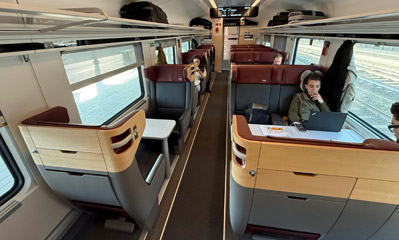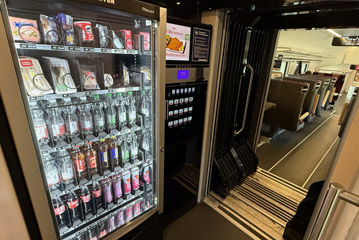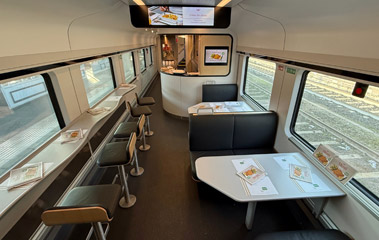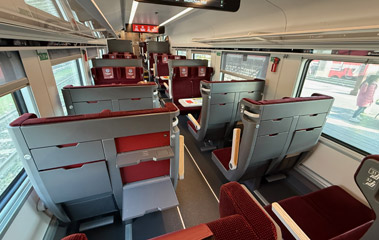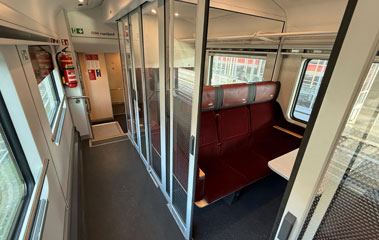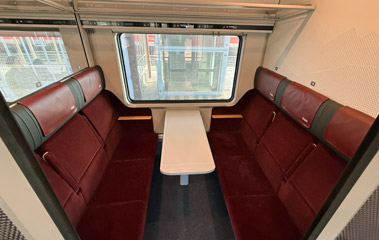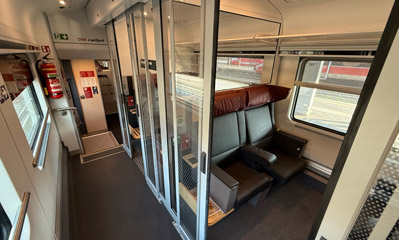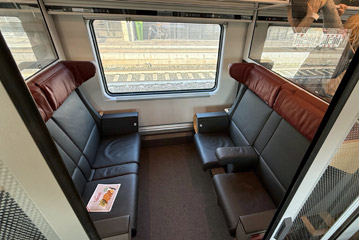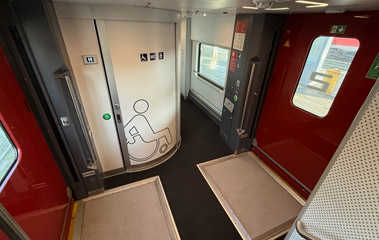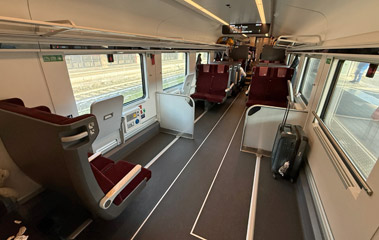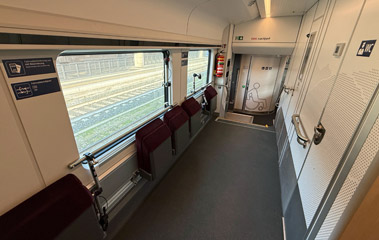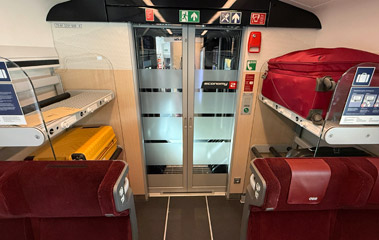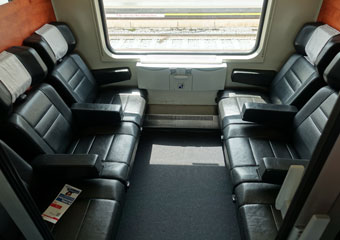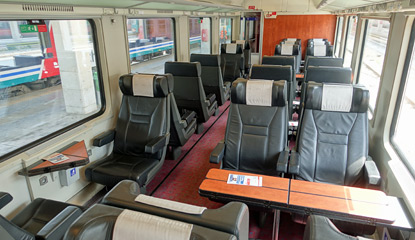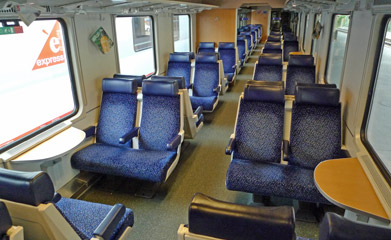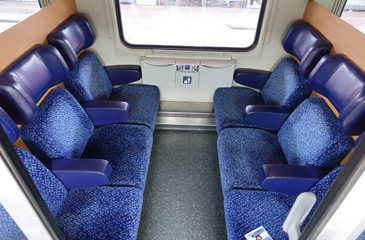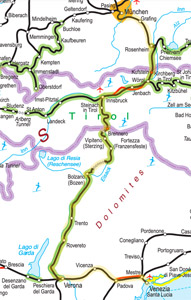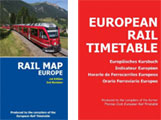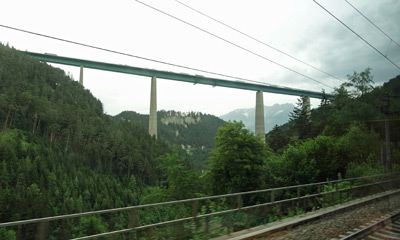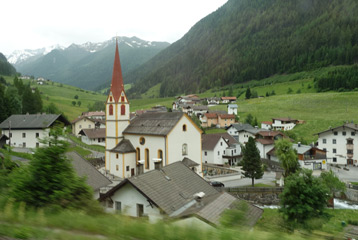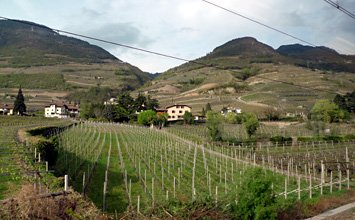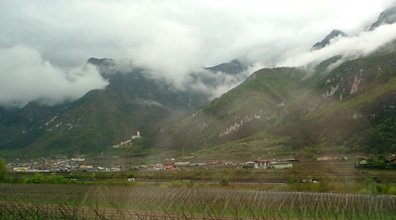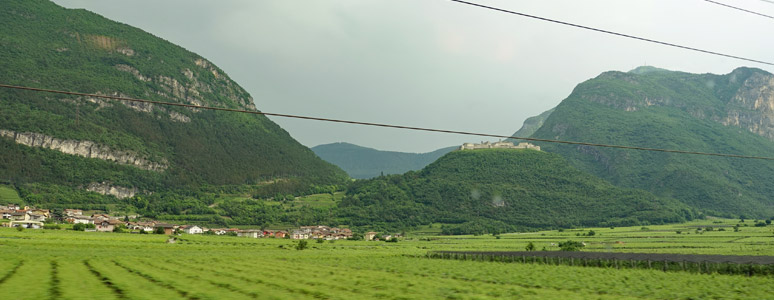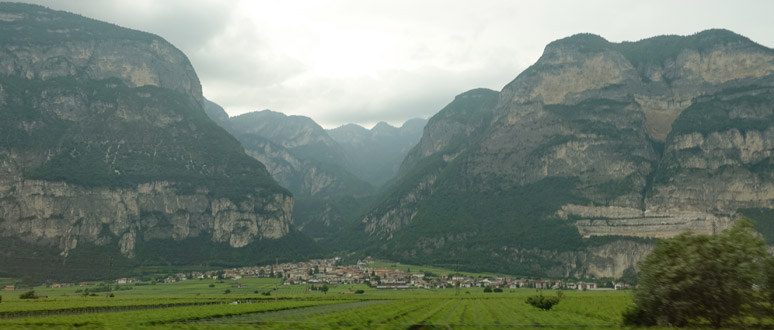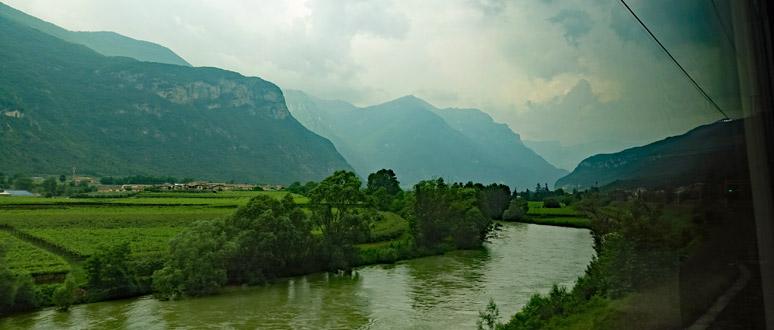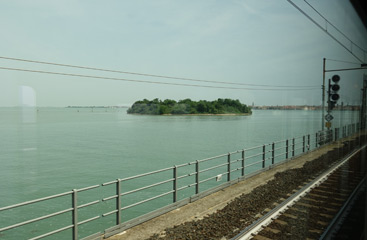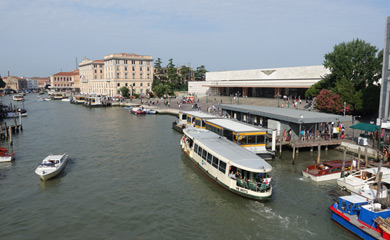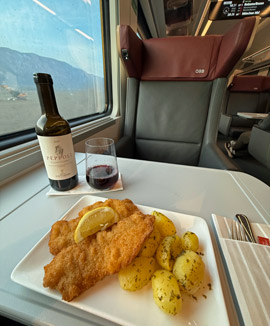 Lunch on a railjet. In 1st class you can be served at your seat. |
Munich to Italy via the Brenner Pass
Swish Austrian railjet trains link Munich, Innsbruck & Verona every two hours through the day, with restaurant car, power sockets at all seats & free WiFi. 2 trains per day extend to/from Venice, and 2 per day to/from Bologna. Run jointly by ÖBB (Austrian Railways) and DB (German Railways), they travel through the scenic Brenner Pass between Innsbruck & Verona, see the photos & video below. The journey is a treat, sit back with a glass of wine and enjoy.
![]() What are the
new railjet trains like?
What are the
new railjet trains like?
![]() What are the
old EuroCity trains like?
What are the
old EuroCity trains like?
![]() Video: Through the
Brenner Pass
Video: Through the
Brenner Pass
![]() Station guides:
Munich Hbf,
Innsbruck Hbf,
Verona Porta Nuova,
Venice Santa Lucia
Station guides:
Munich Hbf,
Innsbruck Hbf,
Verona Porta Nuova,
Venice Santa Lucia
Train times southbound 2026
Train times northbound 2026
Notes for timetable
RJ = New generation railjet with 2nd, 1st & business class, restaurant car, power sockets at all seats & free WiFi.
EC = EuroCity train, 1st & 2nd class with refreshment trolley.
Change in Verona or Bologna for Florence, Rome & Naples. I'd allow at least 45-60 minutes between trains in case of delay.
RJ 82/83 is extended to/from Rimini and Ancona in summer.
Exact times may vary, with a slightly later departure from Munich southbound, slightly earlier arrival northbound, until 1 June 2026.
Munich to Verona is 446 km (277 miles). Munich to Venice is 565 km (351 miles).
How much does it cost?
Fares from Munich to Verona, Bologna or Venice starts at €27.99 in 2nd class or €39.99 in 1st class.
Fares vary like air fares, so book early and avoid popular times or dates for cheaper fares. Booking opens up to 6 months ahead, but can be less than this.
How to buy tickets
Buy tickets at the German Railways website int.bahn.de.
You can buy tickets in either direction between Munich and Verona, Bologna or Venice at int.bahn.de and print your own ticket or show it on your phone. I recommend registering when prompted, so you can log on at any time and check or reprint tickets. Tips for using int.bahn.de.
You can also buy tickets at www.thetrainline.com, www.raileurope.com or at the Austrian Railways website www.oebb.at.
If your journey involves an onward connection in Italy:
You can buy tickets between Munich or Innsbruck and anywhere in Italy (for example, Florence, Rome, Naples or Milan) in either direction at www.raileurope.com as this also connects to Trenitalia ticketing system.
Set up an enquiry between Munich or Innsbruck and your Italian destination. Click More options, enter Verona (any station) and set stopover duration to 45 minutes. Then run the enquiry and it'll sell you the railjet ticket and a connecting Trenitalia ticket as one seamless transaction. Easy to use in plain English, you can pay in Ł or €, there's a small booking fee. You print your tickets or can show them on your phone.
Interrail & Eurail passholders pay a small surcharge for these Brenner pass EuroCity trains to/from Italy, it is not sufficient to make a normal seat reservation, the Interrail & Eurail reservations guide explains how to make a reservation and pay the fee online.
What are the railjet (RJ) trains like?
From November 2024 all trains on this route are swish modern new-generation railjets, except for one remaining Eurocity. They have economy (2nd), first and business class (in that order), with power sockets at all seats & free WiFi. Unlike earlier railjets, business class consists of four fully-enclosed 4-seat compartments. There's a restaurant car (car 3) with small seating area, first and business class passengers can have food & drink orders taken and served at their seat, no need to visit the restaurant unless you want to. Cars 2, 5 & 7 have vending machines for tea & coffee operated with contactless bank cards which saves going to the restaurant car. Another innovation is luggage racks with built-in cables to secure your bags for peace of mind, they are secured with any NFC card such as a contactless bank card, see the instructions here. These new-generation railjets are easily distinguished from previous railjets as 7 of the 9 cars have low floor centre sections for easy step-free boarding. See video inside the new generation railjets. See seat map.
A new generation railjet at Verona Porta Nuova, showing a low-floor section for easy boarding.
Economy 6-seat compartments. Cars 3, 5, 6, 7 & 8 have two economy class 6-seat compartments at one end, on the higher floor level above the wheels. Note the steps down to the low-floor section and entrance hall. Ideal if you're a family or small group, see seat map.
Business class = 1st class + €15. There are just 16 business class seats in four 4-seat compartments at one end of cars 1 & 2, on the higher floor level above the wheels. Note steps down to the low-floor section & entrance hall. Personally on these railjets I prefer regular first class with open-plan seating.
Wheelchair spaces & accessible toilet in car 4: Above left, no need for a ramp because of the low-floor level-boarding.
What are the EuroCity trains like?
New generation railjets replaced almost all the older EuroCity trains in November 2024, but one departure in each direction still uses old-school EuroCity (EC) cars from the 1990s, with 1st & 2nd class, a refreshment trolley, power sockets at some but not all seats, but no WiFi.
An Austrian EuroCity train at Munich Hbf.
Route map
Travel tips
Should you go 1st or 2nd class?
2nd class is absolutely fine, no need to pay more for 1st class unless you want to. There are no 'extras' in 1st class on these trains, 1st class simply means more leg and elbow room, with seats 2+1 across the car width (in the open-plan cars) rather than 2+2, which means there are solo seats and face-to-face tables-for-two on one side of the aisle in 1st class which are great if you're travelling alone or as a couple. So study the photos of each class above, what you see is what you get. 1st class is usually quieter with more laptops tapping, 2nd class is often busier than 1st class with more families and kids.
Business class
Business class on railjets costs €15 on top of any 1st class fare or railpass. This includes seat reservation and a complimentary drink. Business class on these new-generation railjets consists of fully-enclosed 4-seat compartments, the two seats on each side are offset so you can stretch out your legs without affecting the person opposite. On these new trains business class seats are not so different from first class seats, just a little wider, so if you're solo or a couple I'd stick with a solo seat or face-to-face table-for-two in first class, but business class is nice for a family or small group that wants their own space. See seat map.
Open-plan saloon or classic 6-seat compartment?
When you reserve a seat you'll see a choice of open-plan saloon or classic 6-seat compartment.
Economy class on the new-generation railjets is almost entirely open-plan, but there are several 2nd class 6-seat compartments if you prefer. 1st class is all open-plan. Business class consists of four 4-seat compartments. See seat map.
Quiet zone, family zone
On the railjets you can book seats in a quiet zone if you want a peaceful journey, or in the family zone if you have young kids. See seat map.
Seat reservation optional, but recommended
Reserving a seat costs a few extra euros on top of the fare. If you choose not to reserve a seat you sit anywhere you like in any unreserved seat. A small display above each seat shows whether or not that seat is reserved. Reserving a seat for a long journey is a good idea, I might not bother if travelling solo mid-week in February, but I certainly would reserve a seat if travelling on a Friday or Sunday afternoon or if travelling as a small group of 4, 5 or 6 people who want to be sure of seats together, or at busy times such as Easter, Christmas or the summer holidays.
If you've already bought your ticket but want a reserved seat, you can make a seat reservation separately for a few euros at either the German Railways website int.bahn.de (toggle on Book seat only) or the Austrian Railways website www.oebb.at (tick the Seat reservation only box before running the enquiry).
Tip: I'd use www.oebb.at as it only charges €3 in either class and you can choose your seat from a seat map, int.bahn.de charges €5.50 2nd class or €6.90 1st class and allocates your seat without any choice.
Which side of the train has the best views?
It doesn't make a huge difference, but the best views are arguably on the right hand side of the train going south, left hand side going north. as the valley is mostly on that side as is the little church at Jodok.
First class lounges in Munich or Innsbruck
If you have a 1st class Flexpreis fare for these trains (but not a 1st class railpass or Sparpreis or Super Sparpreis fare) you can use the DB Lounge at Munich Hbf with complimentary wine, beer & free WiFi.
If you have any sort of 1st class ticket or railpass (except a DB Super Sparpreis fare) you can use the ÖBB Lounge at Innsbruck Hbf before or after your journey, with complimentary refreshments & free WiFi.
Station information
See the station guides for Munich Hbf, Innsbruck Hbf, Verona Porta Nuova, Bologna Centrale, Venice Santa Lucia, with tips on station layout and good places for a beer, coffee or meal.
Boarding your train
There's no check-in, just be on board the train a minute before departure time when the doors close. At German & Austrian stations there is free & easy unhindered access between street, concourse, platform & train. At major Italian stations there may be a simple ticket check before accessing the platform area.
Luggage
Like any European train, you take your bags into the train with you and stick them on any suitable rack near your seat. There are overhead racks above your seat which take anything up to backpack size. Nobody weighs or measures bags, so no worries, if you can carry it, it's fine.
An innovation on the new railjets is that luggage racks come with built-in cable ties to secure your bags for peace of mind. The cable is locked and unlocked with any NFC card such as a contactless bank card, see instructions.
Munich Hbf & Venice Santa Lucia are termini with easy level access from street to concourse to platforms without steps, so no problem with wheeled luggage from street or taxi rank to train. Innsbruck Hbf and Verona Porta Nuova have lifts or escalators to all platforms, so no major problem there either.
Food & drink
The new-generation railjets have a restaurant car with small seating area serving snacks, drinks and meals. In first and business class, a steward takes food & drink orders and serves them at your seat, so no need to go to the restaurant car. There are vending machines in cars 2, 5 & 7 selling tea, coffee, drinks & snacks, these accept contactless cards and save you going to the restaurant car just for a coffee - although you'll get a bigger cup and possibly better coffee for a similar price if you do!
On the Eurocity train there's a refreshment trolley serving drinks and snacks.
You are of course free to bring your own food and drink along to eat & drink in your seat, even beer or wine.
Order food & drink & check the train's progress on your phone - on the new railjets
In first & business class on the railjet trains food & drink orders are taken at your seat. But you can short-circuit this process by logging onto the railjet's free WiFi, the ÖBB portal opens up (railnet.oebb.at) with an option to order food for delivery to your seat. You order from the online menu, enter your car & seat number, and hey presto, the steward shows up shortly afterwards with your order. You pay him when he arrives or can pay online with a bank card.
You can find the current restaurant menu at www.oebb.at/en/.../im-zug/bordservice - please let me know if that link stops working.
The intranet also allows you to keep track of the train's speed and whereabouts on your phone, and check arrival times.
WiFi & power outlets
There are power outlets at all seats and free WiFi on the new railjet (RJ) trains. There are power sockets at some but not all seats and no WiFi on EuroCity (EC) trains.
Recommended hotels in Munich, in Innsbruck, in Verona & in Venice.
Scenery & sights on the Brenner route
Between Munich and Innsbruck, the train runs through the Tirol on a broad valley between imposing mountains. Leaving Innsbruck, the train climbs steeply towards the Brenner Pass. snaking through a steep and narrow valley between the peaks parallel with the impressive Brenner pass highway on your right. Watch out for St Jodok, where the train makes a 180 degree turn in a pretty valley, around the village and its church then through the Jodok spiral tunnel, climbing all the way. The summit of the line is reached at Brenner station, 1,371m (4,498 feet) above sea level, the highest point on both the ÖBB (Austrian Federal Railways) & Trenitalia standard-gauge networks. Brenner station is also of course where two dictators met and conferred in 1940, see this Pathé News video. South of Brenner, the valley widens out, with plenty of vineyards in evidence. Look out for hilltop castles and forts, including the large one built in 1838 at Fortezza, just south of the station on the left hand side when going south. Uniquely, in this part of Italy you'll find both Italian and German languages used. You can read more about the Brenner Railway at en.wikipedia.org/wiki/Brenner_Railway.
Mountains on the Brenner route.
Vineyards, mountains and castles south of Brenner.
Watch out for hilltop fortresses, this is an unidentified fortress on a hill overlooking a village. The largest of the bunch is the great fort at Fortezza, built in 1838 to guard the pass (on the right hand side going north, left hand side going south, to the south of the station).
More mountains on the Brenner route, between Brixen and Bolzano.
Hilltop castles as Chiusa-Klausen, south of Brixen as the train gathers speed for Verona.
More scenery between Brixen & Verona, along the river Adige.
The train rumbles over the famous causeway across the lagoon into central Venice, with anticipation building. Arriving at Venice Santa Lucia, on the Grand Canal itself, you walk out to see gondolas & vaporettos right in front of you.
Watch the video
The video takes you through the Brenner on one of the old EuroCity trains, before replacement by railjets in 2024.



